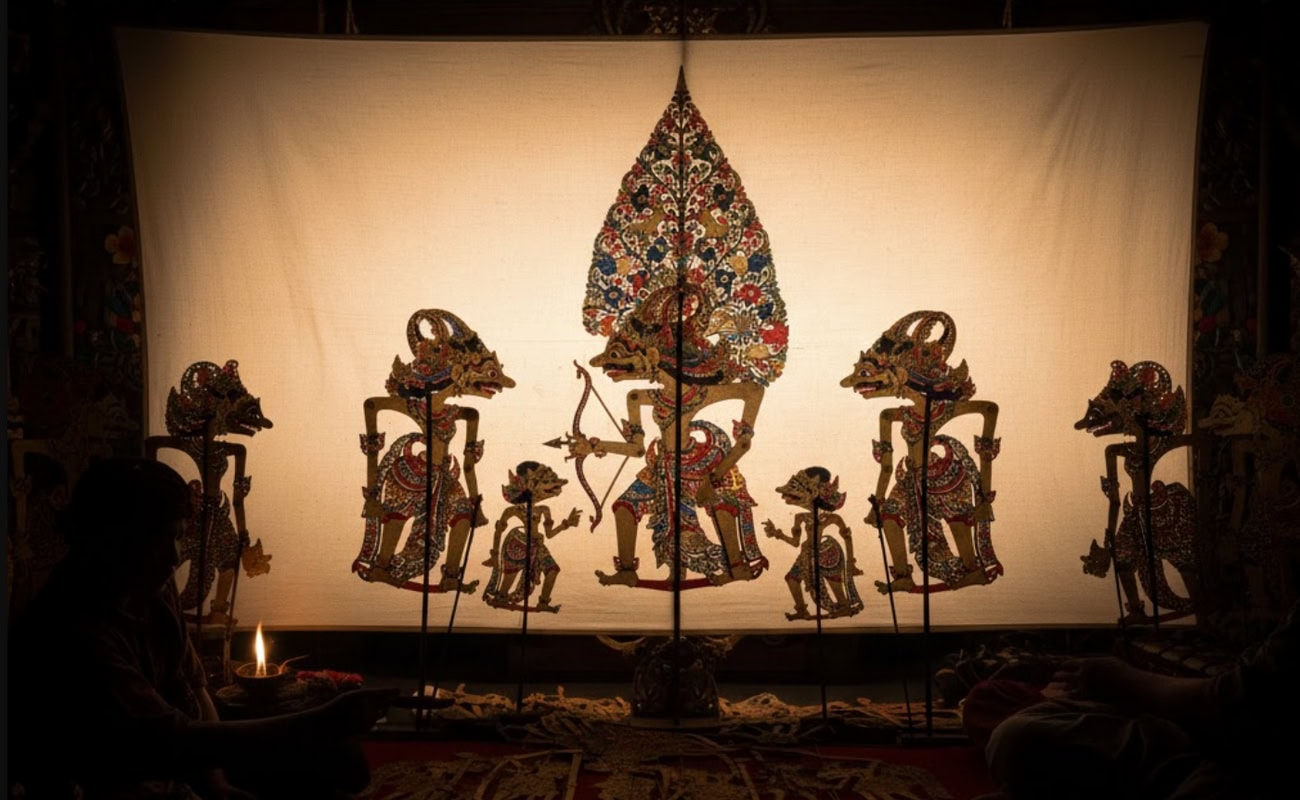In the rich tapestry of Indonesian culture, few art forms are as captivating and deeply symbolic as Wayang Kulit, the traditional shadow puppet theatre. Recognized by UNESCO as a Masterpiece of Oral and Intangible Heritage of Humanity, Wayang Kulit is an ancient storytelling tradition that originated on the island of Java, and later spread to other parts of Indonesia, including Bali and Lombok. It is a mesmerizing blend of intricate craftsmanship, philosophical narratives, and a hauntingly beautiful musical accompaniment, offering a profound glimpse into the spiritual and moral fabric of Indonesian society.
The Art of Shadows: History and Philosophy
The term “Wayang” is derived from the Indonesian word for shadow or ghost (bayang), while “Kulit” means leather, referring to the material from which the puppets are meticulously crafted. The art form is believed to have roots predating the arrival of Hinduism and Buddhism, with early forms likely involving ancestral worship. With the influx of Indian religions, Wayang Kulit became a powerful medium for disseminating Hindu epics, particularly the Ramayana and Mahabharata, adapting them to local contexts and infusing them with Javanese and Balinese philosophical nuances.
At its heart, Wayang Kulit is a metaphor for life itself. The screen represents the world, the puppets are humanity, and the lamp is the divine light or God. The dalang, the puppet master, manipulates the puppets, symbolizing the forces that shape human destiny. The shadows cast on the screen are seen as the ephemeral nature of existence, while the puppets themselves represent the physical forms. This profound philosophical underpinning elevates Wayang Kulit beyond mere entertainment, making it a spiritual experience for both performers and audience.
The Dalang: Master of the Universe
The central figure of any Wayang Kulit performance is the dalang, the puppet master. This individual is a true polymath, possessing an extraordinary array of skills. The dalang is not only responsible for manipulating dozens of intricately carved leather puppets, often simultaneously, but also for narrating the story, singing, providing sound effects, and directing the accompanying gamelan orchestra. They must have an encyclopedic knowledge of the epic tales, a deep understanding of philosophy, and the ability to improvise and engage the audience for hours on end, often from dusk till dawn.
The dalang’s voice is their primary tool, capable of shifting between numerous characters, from booming giants to delicate princesses, each with a distinct vocal quality. Their hands are equally adept, bringing the flat, two-dimensional puppets to life with subtle movements that convey emotion, action, and character. The role of the dalang is highly respected and often passed down through generations, requiring years of rigorous training and dedication.
The Puppets: Intricate Leather Creations
Wayang Kulit puppets are masterpieces of craftsmanship. Each puppet is meticulously hand-carved from buffalo hide, then carefully painted and adorned with intricate details. The arms and sometimes the legs are articulated with buffalo horn or bamboo rods, allowing the dalang to create fluid and expressive movements. The design of each puppet is highly stylized, with specific features, colors, and costumes indicating the character’s personality, social status, and moral alignment.
Characters from the Ramayana and Mahabharata epics form the core repertoire, including noble heroes like Rama and Arjuna, virtuous heroines like Sita, powerful gods, and formidable demons. Alongside these epic figures are the beloved clown-servants (punakawan), such as Semar, Gareng, Petruk, and Bagong, who provide comic relief, offer philosophical commentary, and act as intermediaries between the audience and the often-lofty narratives.
The Gamelan Orchestra: The Soulful Accompaniment
No Wayang Kulit performance is complete without the evocative sounds of the gamelan orchestra. The music is integral to the storytelling, setting the mood, emphasizing dramatic moments, and guiding the rhythm of the narrative. The dalang directs the gamelan with subtle cues, and the musicians respond with a rich tapestry of percussive sounds from gongs, metallophones, and drums, often complemented by stringed instruments and vocalists.
The music is not merely background; it is an active participant in the drama, creating an atmosphere that can be simultaneously thrilling, melancholic, and deeply spiritual. The interlocking melodies and rhythms of the gamelan are perfectly synchronized with the movements of the puppets, creating a seamless and immersive theatrical experience.
A Night of Enchantment: The Performance
A Wayang Kulit performance typically takes place at night, often lasting for several hours, sometimes even through to dawn. The dalang sits behind a white screen, illuminated by a single oil lamp (blencong), which casts the shadows of the puppets onto the screen for the audience. The audience can choose to watch from the front, observing the shadows, or from behind, seeing the dalang at work with the puppets and the gamelan musicians.
The stories often revolve around themes of morality, justice, love, and duty, offering lessons and reflections on the human condition. Despite their ancient origins, these tales remain relevant, addressing universal struggles and triumphs. The performances are not static; they are dynamic and interactive, with the dalang often incorporating contemporary jokes, social commentary, and local references to keep the audience engaged.
Preserving a Living Tradition
In an increasingly modern world, the preservation of Wayang Kulit is a continuous effort. While its popularity has faced challenges from modern entertainment, it remains a cherished cultural icon in Indonesia. Many cultural institutions, schools, and individual artists are dedicated to teaching and performing Wayang Kulit, ensuring that this intricate art form continues to enchant and educate future generations. Visitors can often find performances in cultural centers, particularly in Yogyakarta and Solo in Java, and in some parts of Bali.
Experiencing Wayang Kulit is a journey into the heart of Indonesian heritage. It is a testament to the power of storytelling, the beauty of traditional craftsmanship, and the enduring spiritual depth of a culture that finds profound meaning in the dance of shadows. It is an art form that transcends time, inviting audiences to reflect on the eternal questions of good and evil, destiny, and the human spirit.

